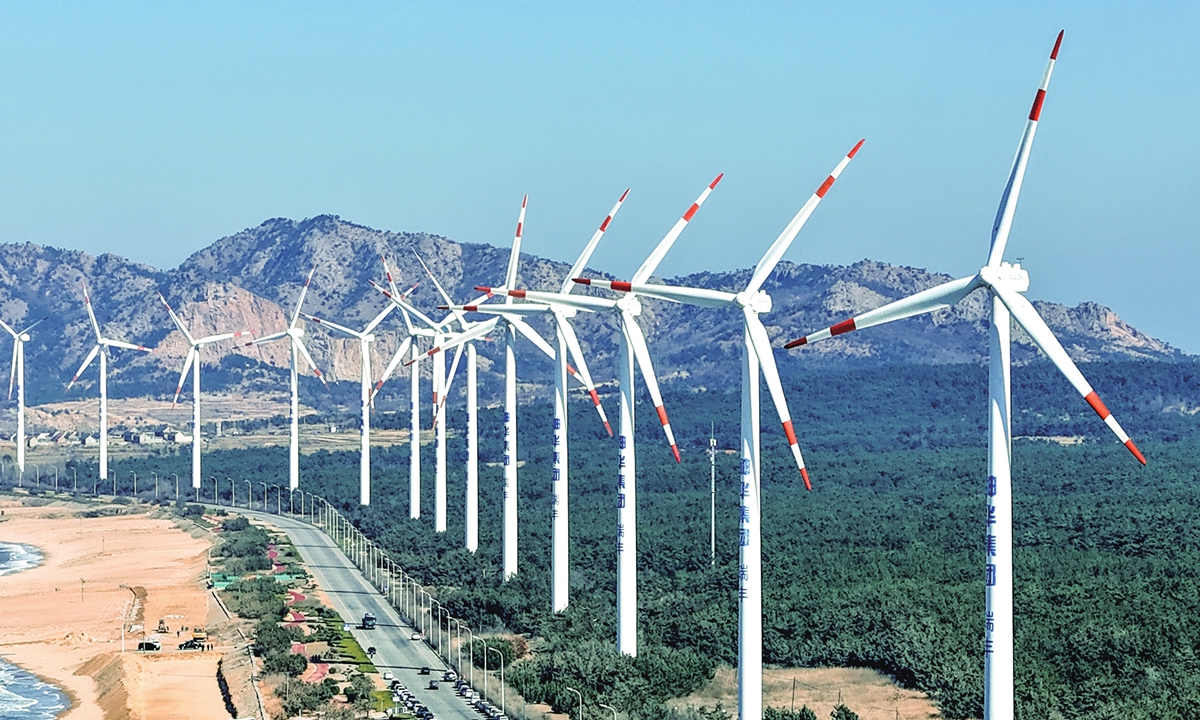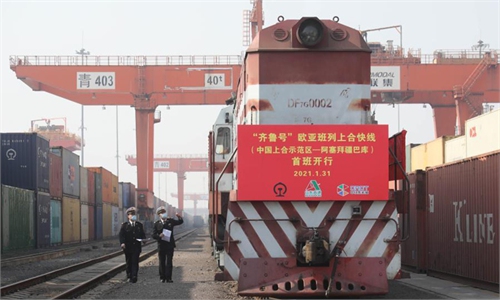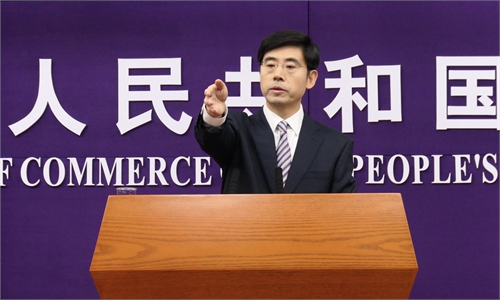
A photo taken on March 19, 2024 shows wind turbines in a coastal area of Rongcheng city, East China's Shandong Province. The city, relying on its rich coastal wind energy resources, vigorously promotes the development of green and clean energy industries and optimizes the energy structure, in a bid to achieve ecological protection and sustainable development. Photo: VCG
Recently, the US and some Western countries, politicians, and media outlets have frequently hyped the narrative of China's so-called "overcapacity," particularly targeting China's emerging new energy sectors, including electric vehicles (EVs) and photovoltaic (PV), for alleged excess production. However, while these countries actively propagate this narrative, they simultaneously intensify efforts to smear and suppress Chinese technological advancements. The US and Western countries continue to subsidize their domestic new energy industries while criticizing China for its subsidies. The narrative echoes the outdated rhetoric that misrepresents China's Belt and Road initiative as a scheme to offload surplus capacity, highlighting a persistent desire in the West to maintain hegemonic ideologies and moral superiority.
Embracing a low carbon economy and green development is part of China's national strategy, driven by its own need to transform its economic structure, develop a competitive green and low-carbon industry, and achieve high-quality growth. The advances in green technology and the rapid development of green industries have significantly enhanced the resilience and vitality of China's economy.
China, as the world's largest developing nation, has been facing the challenges of a large population, limited resources, and a fragile ecosystem during its process of modernization. The country's unprecedented push toward ecological civilization is fundamentally aimed at solidifying the foundation for the Chinese modernization and boosting the inclusiveness of its economy and society.
China's efforts in afforestation and combating desertification, one of the world's most pressing challenges, exemplify its comprehensive strategies to protect and restore ecosystems across the country, resulting in continuous growth in forest coverage over the past three decades and continuous reduction in deserts and sandy lands. These actions and achievements demonstrate Chinese people's active role in transforming natural and ecological wealth into economic and social prosperity, while enhancing ecological and social benefits, the actions have strategically fueled China's high-quality development.
Historically, some Western countries have been discrediting China's rapid economic growth with environmental costs. However, as China now creates one-quarter of the world's new green lands, these countries and their media commentators choose to downplay such successful integration of economic development and environmental protection in China. From 2012 to 2021, China supported an average economic growth of 6.6 percent per year with a 3 percent annual increase in energy consumption, reducing its carbon dioxide emissions per unit of GDP by approximately 34.4 percent and its energy consumption per unit of GDP by 26.4 percent, making it one of the fastest countries in the world to reduce energy intensity.
A healthy ecological environment is the most universally beneficial welfare for the population. From basic production and living standards, China has embarked on green development, to create ecological benefits for all. By addressing major environmental issues that affect public health, China pushes innovation in green, low-carbon technologies to provide high-quality ecological products. The flourishing eco development has made green industries and new productive forces the biggest growing sectors and highlights of China's economy in the new era.
Chinese economy is trying to create a better environment for the Chinese people, and has achieved a transition in economic drivers.
Aiming for precise and scientific pollution control, China significantly advanced the modernization of ecological management, making breakthroughs in key technologies, including flue gas control, water pollution control, ultra-low emissions thermal power plants, and smart environmental monitoring. The technologies have spurred the growth of new industries, including smart cities, green buildings, green transportation, ecological agriculture, rural e-commerce, and village tourism. Notably, China has initiated the integration of ecological management and emerging technologies like big data, AI, and advanced telecommunications like 5G and 6G. The integration has pioneered new paths for eco protection industry, making it a new growth area in China's new productive forces. In 2021, the output of China's energy conservation and environmental protection industry exceeded 8 trillion yuan ($1.1 trillion), making it a substantial force in the green economy.
Triggered by the escalating ecological crisis associated with accelerating industrialization, along with a deeper understanding of nature and the universe, China's promotion of ecological civilization signifies a reflection on and critique of industrial civilization, making it an essential ecological feature of China's modernization. China's green development represents the most extensive and profound socioeconomic transition toward sustainability in the 21st century.
The core of this comprehensive green transition, for China in the new era, is using ecological civilization and green development as strategic pathways and engines of its development, to reshape and lead the new economic pattern of modern China. Over the past decade, China has historically resolved the issue of absolute poverty, fully established a moderately prosperous society. These historic achievements and transitions in China's economic construction in the new era have, on one hand, addressed traditional distortions in the allocation of developmental resources through supply-side structural reforms, by cutting excess capacity, de-stocking, reducing costs, and filling in developmental gaps. The actions have shifted the reliance from increasing resource consumption, rough expansion, and high energy-consuming industries, enabling a "soft landing" for China's traditional heavy industry sector, strongly opposing Western claims of so-called "inevitable hard landing" for the Chinese economy. On the other hand, through high-quality development and new productive forces driven by innovation and green initiatives, China has reshaped its development dynamics. In 2023, China's GDP reached 126.0582 trillion yuan, a nearly 25 percent increase since surpassing the 100 trillion-yuan milestone in 2020. This growth was achieved after China announced its "dual carbon" strategy and targets. It takes on the responsibility of a major global player to vigorously develop non-fossil energy resources and promote the efficient consumption of renewable energies.
Being the world's largest developing country, China has made the great achievement of ecological building and green development with nearly 20 percent of the world's population. It is achieved under the grand historical narrative of Chinese-style modernization, where humans and nature coexist in harmony. This path, which challenges the equation of modernization with Westernization, is unique and unprecedented in human history. It offers lessons for the vast majority of developing countries, which make up about 86 percent of the world's population, on how to achieve modernization without relying on exploitative practices such as land grabbing, slaughter, colonization, or capital-centered approaches.
China's green development not only add more green fields to the planet and expand the global green footprint, but also triggered a new round of industrial transformation. According to a report by the International Energy Agency, in 2023, global renewable energy installation increased 510 million kilowatts, with China contributing more than half of the capacity. In 2022, China's renewable energy generation effectively reduced its domestic carbon dioxide emissions by approximately 2.26 billion tons. Exports of Chinese wind and PV products helped other countries reduce their carbon emissions by about 573 million tons, totaling over 2.8 billion tons of reduced emissions, which is about 41 percent of reduced carbon in the global renewable energy sector. Compared to the traditional paths of industrial civilization and Western capitalist modernization, China's modernization, which seeks harmony between human and nature, represents a peaceful and green rise.
The narrative of China's so-called "overcapacity," propagated by the US and Western countries, is merely a rehashed version of the "China threat" rhetoric, aiming at discrediting and suppressing China's development. The underlying logic reveals the injustices of capitalist coercion and exploitation, as well as the arrogance of defending the global capitalist exploitative system. China's pursuit of ecological civilization is an objective reality that transcends human will, it represents a new trend in the evolution of human civilization. Those who proactively embrace this new civilization will lead the way in shaping its future.
Huang Chengliang is a research fellow at the research institute for Eco-civilization, Chinese Academy of Social Sciences. bizopinion@globaltimes.com.cn



